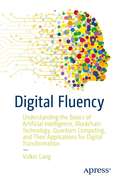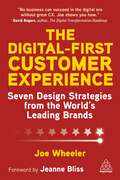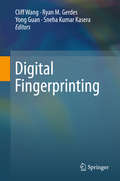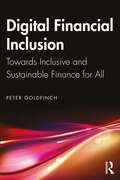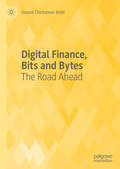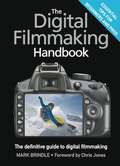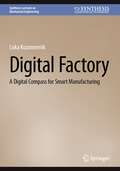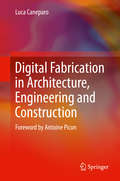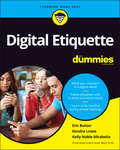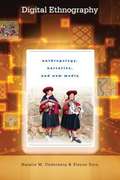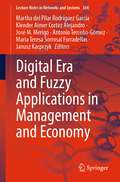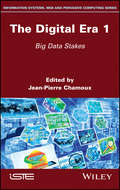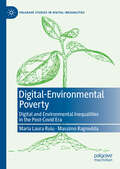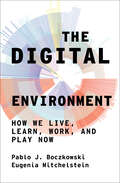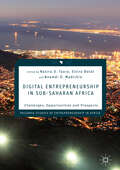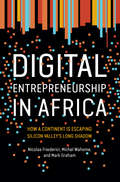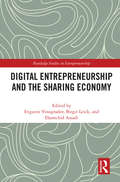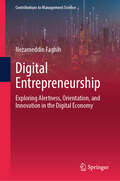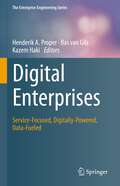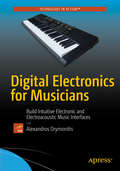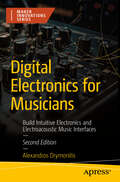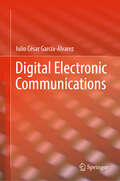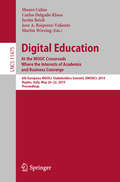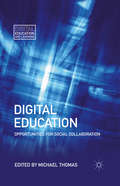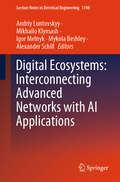- Table View
- List View
Digital Fluency: Understanding the Basics of Artificial Intelligence, Blockchain Technology, Quantum Computing, and Their Applications for Digital Transformation
by Volker LangIf you are curious about the basics of artificial intelligence, blockchain technology, and quantum computing as key enablers for digital transformation and innovation, Digital Fluency is your handy guide. The real-world applications of these cutting-edge technologies are expanding rapidly, and your daily life will continue to be affected by each of them. There is no better time than now to get started and become digitally fluent.You need not have previous knowledge of these versatile technologies, as author Volker Lang will expertly guide you through this digital age. He illustrates key concepts and applications in numerous practical examples and more than 48 catchy figures throughout Digital Fluency. The end of each chapter presents you with a helpful implementation checklist of central lessons before proceeding to the next. This book gets to the heart of digital buzzwords and concepts, and tells you what they truly mean. Breaking down topics such as automated driving and intelligent robotics powered by artificial intelligence, blockchain-based cryptocurrencies and smart contracts, drug development and optimization of financial investment portfolios by quantum computing, and more is imperative to being ready for what the future of industry holds. Whether your own digital transformation journey takes place within your private or public organization, your studies, or your individual household, Digital Fluency maps out a concrete digital action plan for all of your technology and innovation strategy needs.What You Will Learn Gain guidance in the digital age without requiring any previous knowledge about digital technologies and digital transformationGet acquainted with the most popular current and prospective applications of artificial intelligence, blockchain technology, and quantum computing across a wide range of industries including healthcare, financial services, and the automobile industryBecome familiar with the digital innovation models of Amazon, Google, Microsoft, IBM, and other world-leading organizations Implement your own digital transformation successfully along the eight core dimensions of a concrete digital action planWho This Book Is ForThought-leaders, business executives and industry strategists, management and strategy consultants, politicians and policy makers, entrepreneurs, financial analysts, investors and venture capitalists, students and research scientists, as well as general readers, who want to become digitally fluent.
The Digital-First Customer Experience: Seven Design Strategies from the World’s Leading Brands
by Joe WheelerThe definitive guide to designing digital-first experiences customers love. In his third book on the topic of customer experience, bestselling author and consultant Joe Wheeler tackles the challenges many organizations are facing as they attempt to design compelling experiences in a digital-first world. It features case studies of leading brands including Lemonade, Spotify, CEMEX, VMware, Starbucks, NIKE and Amazon.Part One introduces the new "3 Cs", key trends associated with technology convergence, competition and culture change in a post-pandemic world. Part Two takes a deep dive into seven design strategies, from designing emotional peaks across channels to empowering customers through immersive experiences that merge physical and digital assets. Part Three provides a playbook for how to design digital-first experiences, including how to solve the right problems, develop a measurable business case, design digital-first experiences customers love and execute the new design at scale.
Digital Fingerprinting
by Cliff Wang Ryan M. Gerdes Yong Guan Sneha Kumar KaseraThis is the first book on digital fingerprinting that comprehensively covers the major areas of study in a range of information security areas including authentication schemes, intrusion detection, forensic analysis and more. Available techniques for assurance are limited and authentication schemes are potentially vulnerable to the theft of digital tokens or secrets. Intrusion detection can be thwarted by spoofing or impersonating devices, and forensic analysis is incapable of demonstrably tying a particular device to specific digital evidence. This book presents an innovative and effective approach that addresses these concerns. This book introduces the origins and scientific underpinnings of digital fingerprinting. It also proposes a unified framework for digital fingerprinting, evaluates methodologies and includes examples and case studies. The last chapter of this book covers the future directions of digital fingerprinting. This book is designed for practitioners and researchers working in the security field and military. Advanced-level students focused on computer science and engineering will find this book beneficial as secondary textbook or reference.
Digital Financial Inclusion: Towards Inclusive and Sustainable Finance for All
by Peter GoldfinchWith the arrival of the ‘Internet of Things’ (IoT), smartphones, real-time payments systems, plus FinTech activity, Financial Inclusion services can now be integrated into a country’s National Payment System (NPS), which means there should be no systemic barriers to transitioning the socio-economic pyramid, as actors build their financial status. This, however, is not the case. This book is a comprehensive guide to understanding the transition of financial services from cash-based to digital-based systems, with a focus on Financial Inclusion.It explores the success of Financial Inclusion programs in promoting economic activity and lifting people out of poverty. It does not concentrate on a single deployment or approach, rather, it takes a broader view. The book surveys the technology and infrastructure required to build digital payment systems, as well as the regulatory and governance frameworks that enable their operation, however, the major focus is on the incorporation of these financial services within communities in order to deliver social outcomes. The book opens the conversation, proposing a new method of measuring Financial Inclusion. It takes a critical but constructive look at the field over the last 20+ years and discusses the key learnings. It examines the Kenya mobile money approach to Financial Inclusion, compared with the Indian bank lead approach, and delivers a broad-based plan on how the programs can be more effective in the future.Financial Inclusion requires a pathway to progress, through a period of technology transformation. The foundation is provided by this book and the reader, on finishing it, will have a comprehensive appreciation of the subject matter.
Digital Finance, Bits and Bytes: The Road Ahead
by Vasant Chintaman JoshiThe book encompasses the broad field of e-Finance and its transformation. After reviewing the developments in the economic and the technology fields, it examines how the insurance, banking, and securities trading firms are bringing about the digital revolution and adapting in the same breath to the changed socio-economic environment. Add to it, the “Rogue Elements”, the field of cyber crimes is covered on a priority basis. The book also covers the inevitable changes in fields of HR and Marketing and the crucial role of the regulators. Looked at through the eyes of Corporate Planner, the book does provide a road map for the financial institutions (FIs).
The Digital Filmmaking Handbook
by Chris Jones Mark BrindlePart of the perennially best-selling Quercus Digital Photography series, this comprehensive guide features everything you need to know to make a digital film, from conception to finished product. Using clear, step-by-step instruction, The Digital Filmmaking Handbook concisely illustrates the technical and creative challenges of digital filmmaking for novices and professionals alike, spanning topics from conception to execution: - Planning a shoot: how to make a storyboard - Set preparation: dressing and lighting a set - Principal photography: filming with HD and DSLR cameras--including the latest advice on equipment, accessories, and software - Advanced editing: software and practices - Post-production: digital effects and Packed with tips and tricks to develop both your creative vision and your technical know-how, The Digital Filmmaking Handbook is the ultimate resource for all your filmmaking needs. From the Trade Paperback edition.
Digital Factory: A Digital Compass for Smart Manufacturing (Synthesis Lectures on Mechanical Engineering)
by Luka KozamernikThe Digital Factory is a comprehensive guide for leaders in the manufacturing sector looking to navigate the complex digital transformation landscape. Digitalization has become crucial to any company's success in today's fast-paced business world. However, making sense of the plethora of information on approaching digitalization can be challenging, leaving many leaders needing clarification. The pressure to make the right decisions can be overwhelming, with various groups advocating their interests. Without a clear vision and understanding of digital transformation, leaders may lack confidence in making the right company decisions. And with access to specific and valuable knowledge about digital transformation, achieving optimal returns for the company can be more accessible. This book is designed to empower leaders in the manufacturing sector to overcome these challenges.
Digital Fabrication in Architecture, Engineering and Construction
by Luca CaneparoDigital technologies are changing the relationship between design and construction: with computer models, CAD/CAM, and prototyping, designers can gain direct control of building and construction processes. The ability to digitally model designs, and thus to use those models directly in the context of production, creates a synthesis between design and construction in keeping with the tradition of the close relationship between design and craftsmanship, between the quality of the design and the rules of the craft. The evolution of the culture of design and construction is the underlying theme of this book. The aim is to discuss the direction that innovation is now taking, with a particular focus on today's cutting-edge architectures. The method addresses the ways in which different societies have dealt with the issues of their age regarding design and construction, the different contributions provided by various techniques, and with them the meanings expressed by the architecture. As building design using digital tools requires specific skills in the fabrication processes and in the languages used by information technology, the book also offers a practical guide to new methods and techniques of managing and controlling fabrication for AEC. A systematic analysis of new skills used in the design process presents an overview of opportunities for architects and engineers. By collecting information on significant projects and analyzing them, the book explores the technical and artistic potential of digital technology. The cases studied are the outcomes of groundbreaking projects which were able to give form and significance to technological research. They show that digital tools are not the exclusive prerogative of large firms but can also be adopted by teams working across small and medium-sized firms - firms which have been able to use informed research to link innovative design with the possibilities offered by digital fabrication in architecture.
Digital Etiquette For Dummies
by Eric Butow Kendra Losee Kelly Noble MirabellaMind your online P's and Q's with this expert digital manners guide Conducting yourself online can be challenging. It sometimes seems like the web and social media is tailor-made to cause upset and anger. But, with the right guide, anyone can learn how to be a beacon of civility and politeness online. In Digital Etiquette For Dummies, a team of online communication experts share their combined insights into improving your presence on social media, writing emails that exude positivity and clarity, behaving correctly in virtual meetings, and much more. You'll become a paragon of politeness as you learn to apply the timeless rules of etiquette to the unique environment of the web, social media, email, Zoom, and smartphones. In this book, you'll also: Learn near-universal etiquette rules for email, social media, cellphones, and more Discover ways to make sure that your polite attitude isn't being lost in the text-only context of a business email Avoid common social media pitfalls and digital faux pas that can trip up even the most careful communicators A great handbook for anyone who uses digital communication in business or in their personal life (so, pretty much everyone), Digital Etiquette For Dummies also belongs on the reading lists of those trying to improve their online interactions on social media.
Digital Ethnography: Anthropology, Narrative, and New Media
by Natalie M. Underberg Elayne ZornDigital ethnography can be understood as a method for representing real-life cultures through storytelling in digital media. Enabling audiences to go beyond absorbing facts, computer-based storytelling allows for immersion in the experience of another culture. A guide for anyone in the social sciences who seeks to enrich ethnographic techniques, Digital Ethnography offers a groundbreaking approach that utilizes interactive components to simulate cultural narratives. Integrating insights from cultural anthropology, folklore, digital humanities, and digital heritage studies, this work brims with case studies that provide in-depth discussions of applied projects. Web links to multimedia examples are included as well, including projects, design documents, and other relevant materials related to the planning and execution of digital ethnography projects. In addition, new media tools such as database development and XML coding are explored and explained, bridging the literature on cyber-ethnography with inspiring examples such as blending cultural heritage with computer games. One of the few books in its field to address the digital divide among researchers, Digital Ethnography guides readers through the extraordinary potential for enrichment offered by technological resources, far from restricting research to quantitative methods usually associated with technology. The authors powerfully remind us that the study of culture is as much about affective traits of feeling and sensing as it is about cognition—an approach facilitated (not hindered) by the digital age.
Digital Era and Fuzzy Applications in Management and Economy (Lecture Notes in Networks and Systems #384)
by Martha del Pilar Rodríguez García Klender Aimer Cortez Alejandro José M. Merigó Antonio Terceño-Gómez Maria Teresa Sorrosal Forradellas Janusz KacprzykThis book aims to contribute to the discussion about the implications of fuzzy logic, neural networks, digital era, and other intelligent techniques on organizations. This book will be very useful for academic researchers and postgraduate students aiming to introduce themselves to the field of quantitative techniques for overcoming uncertain environments and developing models to make decisions. Developments in other theories and socioeconomic and computational changes have shed light on the importance of fuzzy applications in social sciences. The treatment of uncertainty in the economic and business analysis is fundamental and requires instruments compatible with the uncertain environment of economics and business, because most of the traditional models have been overtaken by this reality when trying to make decisions with uncertain information. In the face of information technology, digitization, and uncertainty, organizations confront new opportunities and challenges. In order to take advantage of these opportunities and overcome current and future challenges, it is needed to understand the evolution of these phenomenon.
The Digital Era 1: Big Data Stakes
by Jean-Pierre ChamouxFor 200 years, industry mastered iron, fire, strength and energy. Today, electronics shapes our everyday objects, integrating chips: computers, phones, keys, games, household appliances, etc. Data, software and calculation frame the conduct of humankind, and everything is translated into data. The first volume in this series analyzes the stakes of the massive data which accumulate on the Internet, keeping track of our actions and gestures, the state of the world and our knowledge.
Digital-Environmental Poverty: Digital and environmental inequalities in the post-covid era (Palgrave Studies in Digital Inequalities)
by Massimo Ragnedda Maria Laura RuiuThis book analyzes and understands the complexity of digital poverty by considering its intersecting nature with socioeconomic and environmental poverty. The rapid digital acceleration that has characterized contemporary society in recent decades, notably accelerated by the COVID-19 pandemic, has profoundly reshaped societal structures and dynamics. Our direction depends on how we integrate digital technologies into social structures, utilize them for environmental protection, and master their use rather than being passive consumers.Digital Environmental Poverty is split into three sections. Section I explores the multidimensional nature of poverty, emphasizing the necessity to view it beyond economic terms, and placing it within the contemporary digital-environmental evolution. Section II focuses on the environmental dimension of poverty. Section III offers case studies illustrating the interplay between social, digital, and environmental poverty. The conclusion provides recommendations to anticipate and mitigate the risk of digital environmental poverty.
The Digital Environment: How We Live, Learn, Work, and Play Now
by Pablo J. Boczkowski Eugenia MitchelsteinUnderstanding digital technology in daily life: why we should think holistically in terms of a digital environment instead of discrete devices and apps.Increasingly we live through our personal screens; we work, play, socialize, and learn digitally. The shift to remote everything during the pandemic was another step in a decades-long march toward the digitization of everyday life made possible by innovations in media, information, and communication technology. In The Digital Environment, Pablo Boczkowski and Eugenia Mitchelstein offer a new way to understand the role of the digital in our daily lives, calling on us to turn our attention from our discrete devices and apps to the array of artifacts and practices that make up the digital environment that envelops every aspect of our social experience. Boczkowski and Mitchelstein explore a series of issues raised by the digital takeover of everyday life, drawing on interviews with a variety of experts. They show how existing inequities of gender, race, ethnicity, education, and class are baked into the design and deployment of technology, and describe emancipatory practices that counter this--including the use of Twitter as a platform for activism through such hashtags as #BlackLivesMatter and #MeToo. They discuss the digitization of parenting, schooling, and dating--noting, among other things, that today we can both begin and end relationships online. They describe how digital media shape our consumption of sports, entertainment, and news, and consider the dynamics of political campaigns, disinformation, and social activism. Finally, they report on developments in three areas that will be key to our digital future: data science, virtual reality, and space exploration.
Digital Entrepreneurship in Sub-Saharan Africa: Challenges, Opportunities and Prospects (Palgrave Studies of Entrepreneurship in Africa)
by Nasiru D. Taura Elvira Bolat Nnamdi O. MadichieThis pioneering collection seeks to understand why and how some digital enterprises in Africa progress while others firms either stagnate or regress. Using a range of detailed case studies, it addresses the challenges and barriers that are in place and how some outstanding digital firms deal with operating in a hostile business environment. While digital platforms have created equal access for small businesses, many digital entrepreneurs in Africa continue to struggle with local environments replete with corruption, and other economic inefficiencies. The contributions move the debate forward by addressing the challenges, opportunities, and prospects of digital enterprise in Africa. Placing special emphasis on how African new entrant digital firms are shaping the landscape and forging a new beginning for Africa, this book offers entrepreneurial perspectives to both researchers and policy-makers seeking to support and stimulate entrepreneurship in the new era.
Digital Entrepreneurship in Africa: How a Continent Is Escaping Silicon Valley’s Long Shadow
by Nicolas Friederici Michel Wahome Mark GrahamThe hope and hype about African digital entrepreneurship, contrasted with the reality on the ground in local ecosystems.In recent years, Africa has seen a digital entrepreneurship boom, with hundreds of millions of dollars poured into tech cities, entrepreneurship trainings, coworking spaces, innovation prizes, and investment funds. Politicians and technologists have offered Silicon Valley-influenced narratives of boundless opportunity and exponential growth, in which internet-enabled entrepreneurship allows Africa to "leapfrog" developmental stages to take a leading role in the digital revolution. This book contrasts these aspirations with empirical research about what is actually happening on the ground. The authors find that although the digital revolution has empowered local entrepreneurs, it does not untether local economies from the continent's structural legacies.
Digital Entrepreneurship and the Sharing Economy (Routledge Studies in Entrepreneurship)
by Evgueni VinogradovThe digital and increasingly digitised world is shaped by the interplay of new technological opportunities and ubiquitous societal trends. Both lead to drastic changes facing artificial intelligence (AI), cryptocurrencies and block-chain technologies, internet of things, technology-based surveillance, and other disruptive innovations. These developments facilitate the rise of the sharing economy and open for a variety of new entrepreneurial opportunities that businesses can take up. The novel entrepreneurial opportunities, however, imply a paradigmatic shift in the understanding of entrepreneurship. This book combines digital entrepreneurship with the sharing economy. It presents cutting-edge research for scholars and practitioners interested in either one of the topics – digital entrepreneurship or sharing economy – or their connection. The book addresses three major ways to become entrepreneurial in the sharing economy: digital entrepreneurship through creating novel sharing-economy platforms; technology entrepreneurship through the exploitation of sharing-economy platforms; and business model innovation or business model change influenced by the sharing economy. The book also highlights governance questions on digital entrepreneurship in the sharing economy, which are highly relevant for businesses, the economy, and society. The book will be of interested to researchers, academics, and students in the field of business and entrepreneurship, with a special focus on digital entrepreneurship.
Digital Entrepreneurship: Exploring Alertness, Orientation, and Innovation in the Digital Economy (Contributions to Management Science)
by Nezameddin FaghihFocusing on emerging features of digital transformation, digital economy, digital innovation, and digital entrepreneurship, this edited volume highlights new aspects of digital transformation and research progress in the field. Chapters cover a wide range of topics such as: promoting the growth of the digital economy through the alertness of entrepreneurs; predicting entrepreneurial performance through the lens of entrepreneurial orientation and digital adoption with a machine learning approach; proposing a guide to emphasize the key aspects of social media analytics; examining the digital pathology ecosystem and key drivers for investment in more efficient disease diagnosis and monitoring; exploring how humane orientation contributes to the intention to use digital entrepreneurship with a gender perspective. Concluding with a review of the extant digital economy literature, the volume proposes a future research agenda which will be useful not only for researchers and academics, but also for entrepreneurs and policymakers.
Digital Enterprises: Service-Focused, Digitally-Powered, Data-Fueled (The Enterprise Engineering Series)
by Henderik A. Proper Bas Van Gils Kazem HakiThis book explores different aspects of and provides concrete suggestions to meet the three main challenges for becoming a “Digital Enterprise”: the transition to the digital age, the emergence of service ecosystems, and the growing role of data as a key underlying resource. As a result of these intertwined and mutually amplifying trends, today’s enterprises are confronted with several challenges that profoundly impact their design, from the definitions of products and services offered to their clients via the business processes that deliver these products and services to the underlying IT infrastructure.The contributions which are written by leading enterprise architecture researchers and managers of large corporations cover four key aspects which form each one part of the book: Part I presents experiences how different enterprises currently already need to embrace and exploit new challenges like blockchain, customer-centric services, or value co-creation networks. Part II looks at the need for a new design logic, i.e. the need for new ways of thinking regarding the design of enterprises. Part III is concerned with the coordination needed among different stakeholders of the ensuing continuous transformations. Part IV eventually reflects on the ongoing consequences for enterprise modeling as used to capture both the current affairs of an enterprise, as well as design/study its possible future affairs.The target audience of this book are both master and PhD level students who want to gain insights into key aspects of the challenges confronting digital enterprises, as well as enterprise architects and information managers working in enterprises that are on their way to become digital.
Digital Electronics for Musicians
by Alexandros DrymonitisDigital Electronics for Musicians is the perfect book for musicians who want to dive into the world of computer music and physical computing. This book is aimed at adventurous musicians who want to learn about music programming with Arduino, sensors, and Pure Data, and how to make new interfaces and even new instruments with that knowledge. You'll learn the basics of the Pure Data and Arduino languages, how to incorporate sensors into your musical projects, and how to use embedded computers, like the Raspberry Pi, to create stand-alone projects. Along the way, you'll learn how to create a variety of innovative (Mark, Michelle, I guess they are innovative, but not 100% sure) musical projects, including an interactive bow for stringed instruments, a MIDI clavier synthesizer, an interactive drum set, a patch-bay matrix synthesizer, a guitar looper, and even a DIY theremin. If you are a musician or tinkerer who wants to explore the world of electronic and electroacoustic music and musical interfaces with Arduino, sensors, and Pure Data, Digital Electronics for Musicians is the book for you. What you'll learn Learn the basics of the Pure Data and the Arduino languages Learn more about the available sensors on the market, and how you can incorporate them into your musical projects Focus on physical computing by combining Arduino and Pure Data, bringing the physical world to the world of the computers Make use of additional libraries that extend the capabilities of the Arduino Make use of external objects in Pure Data that help achieve certain goals, depending on the project Learn how a Pure Data patch functions and be able to modify other people's work that fits your needs Learn how the Arduino language works, enabling the modification of already existing code, according to your needs Get insight on the serial communication between the Arduino and Pure Data Learn how to approach various programming challenges in different ways Who this book is for Musicians who want to explore the world of electronic and electroacoustic music and musical interfaces with Arduino, sensors, and Pure Data. Table of Contents Chapter 1: Introduction to Pure Data Chapter 2: Intro to Arduino Chapter 3: Embedded computers and going wireless Chapter 4: Getting started with musical applications Chapter 5: A simple synthesizer using a MIDI keyboard and Arduino Chapter 6: An interactive bow Chapter 7: An interactive drum set Chapter 8: A DIY Theremin Chapter 9: Making a looper Chapter 10: A patch-bay matrix synthesizer
Digital Electronics for Musicians: Build Intuitive Electronics and Electroacoustic Music Interfaces (Maker Innovations Series)
by Alexandros DrymonitisDive into the world of computer music and physical computing and stay ahead of the melodic curve. This book is aimed at adventurous musicians who want to learn about music programming with Arduino, sensors, and Pure Data, and how to make new interfaces and instruments with that knowledge. In this updated version, you can expect a wave of updates that bring the content in sync with the latest tech trends. The book now features revamped code and visuals throughout, all tailored to match the cutting-edge versions of Pure Data, Arduino IDE, and the powerful Raspberry Pi 5. What's even more thrilling is the integration of the Bela platform for audio enthusiasts, alongside an expanded wireless toolkit that includes both Wi-Fi and the trusty XBee. To ensure a smoother journey, there are more project-enhancing images to guide you, and a brand-new chapter dedicated to AI, based on the author's innovative neuralnet object for Pure Data, as showcased in the AIMC conference proceedings. You’ll start with the basics of the Pure Data and Arduino languages, how to incorporate sensors into your musical projects, and how to use embedded computers, like the Raspberry Pi, to create stand-alone projects. Along the way, you’ll learn how to create a variety of innovative musical projects, including an interactive glove that can be used bystringed instrumentalists or other musicians, an interactive drum set, a patch-bay matrix synthesizer, a guitar looper, a DIY theremin, and even DIY instruments that incorporate AI. If you are a musician or tinkerer who wants to explore the world of electronic and electroacoustic music, then Digital Electronics for Musicians, Second Edition is the book for you. What You Will Learn Incorporate sensors into your musical projects. Combine Arduino and Pure Data to bring the physical world to computers. Use additional libraries that extend the capabilities of the Arduino. Work with external objects in Pure Data and create your own patches from scratch. Write your own sketches with Arduino. Who This Book Is For Musicians who want to explore the world of electronic and electroacoustic music.
Digital Electronic Communications
by Julio César García-ÁlvarezThis book provides the basic concepts of electronic digital communication, applied to professional practice in communications engineering. The book begins with basic concepts of information theory and explains the need for digital communications, continuing with the basic schemes of digital communication prior to multiplexing, which applies to current digital communication networks, such as LTE, 5G and 6G. The book is intended for researchers, professionals, and second-year students of electrical engineering, electronics or telecommunications. It can also be useful to students in computer science, engineering physics or other disciplines who develop projects involving electronic communication systems.
Digital Education: 6th European MOOCs Stakeholders Summit, EMOOCs 2019, Naples, Italy, May 20–22, 2019, Proceedings (Lecture Notes in Computer Science #11475)
by Mauro Calise Carlos Delgado Kloos Justin Reich Jose A. Ruiperez-Valiente Martin WirsingThis book constitutes the proceedings of the 6th European Conference on Massive Open Online Courses, EMOOCs 2019, held in Naples, Italy, in May 2019. The 15 full and 6 short papers presented in this volume were carefully reviewed and selected from 42 submissions. Massive Open Online Courses (MOOCs) have marked a milestone in the use of technology for education. The reach, potential, and possibilities of EMOOCs are immense. But they are not only restricted to global outreach: the same technology can be used to improve teaching on campus and training inside companies and institutions. The chapter 'Goal Setting and Striving in MOOCs. A Peek inside the Black Box of Learner Behaviour' is open access under a CC BY 4.0 license at link.springer.com.
Digital Education: Opportunities for Social Collaboration
by Michael ThomasA collection of content-based chapters and case studies examining the pedagogical potential and realities of digital literacies in education. The book aims to examine a number of foundational aspects of Web 2. 0 technologies and social media applications and to understand the implications for teaching, learning, and professional development.
Digital Ecosystems: Interconnecting Advanced Networks with AI Applications (Lecture Notes in Electrical Engineering #1198)
by Andriy Luntovskyy Alexander Schill Mikhailo Klymash Mykola Beshley Igor MelnykThis book covers several cutting-edge topics and provides a direct follow-up to former publications such as “Intent-based Networking” and “Emerging Networking”, bringing together the latest network technologies and advanced AI applications. Typical subjects include 5G/6G, clouds, fog, leading-edge LLMs, large-scale distributed environments with specific QoS requirements for IoT, robots, machine and deep learning, chatbots, and further AI solutions. The highly promising combination of smart applications, network infrastructure, and AI represents a unique mix of real synergy. Special aspects of current importance such as energy efficiency, reliability, sustainability, security and privacy, telemedicine, e-learning, and image recognition are addressed too. The book is suitable for students, professors, and advanced lecturers for networking, system architecture, and applied AI. Moreover, it serves as a basis for research and inspiration for interested professionals looking for new challenges.
